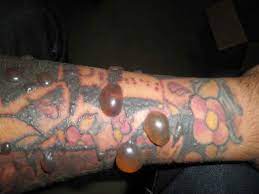
Professional tattoo artists use tattoo ink containing numerous compounds that may trigger allergic reactions ranging from acute inflammation to granulomatous or pseudo-lymphomatous reactions. Tattoo ink allergies may be rare but can be severe. Before getting inked, visit an allergist and have them conduct a patch test on you first.
Patch Test
Patch tests are screening tools to identify the source of allergic contact dermatitis. Your physician will apply patches with different suspected irritants directly onto your back and secure them with hypoallergenic tape for 48 hours; during this time, you should avoid bathing/showering (except sponge baths) and sweating. Once the patches are removed, your dermatologist will carefully observe each reaction site. Mild reactions might appear as slightly elevated pink areas with mild vesiculation, while stronger reactions might manifest as red bumps or papulovesicles. Patch test reactions vary significantly in severity, from mild skin rashes to large swellings; it can take hours or days for positive responses to appear. Still, patch tests remain one of the most reliable ways of identifying external allergens responsible for tattoo allergies.
Skin Test
A healthcare provider typically administers skin tests on either your arm or back. After cleaning the area and drawing minor marks with a pen, allergen drops will be placed on each spot; then, a lancet will be used to prick the skin at each allergen location. If an allergic reaction develops at one of these sites (wheal), then the size of the wheal helps determine severity. Adding in controls like glycerin or saline to monitor reactions indicates you may have sensitive skin, thus interpreting test results even more cautiously. This allergy test can detect immediate responses to up to 50 allergens simultaneously. It’s commonly used to identify pollen, molds, pet dander, and food allergies. Since antihistamines interfere with skin testing results, you should discontinue their use several days before before undertaking this testing.
Blood Test
Suppose a patch test doesn’t provide good results, or you have skin conditions or medications that impede testing processes. Blood allergy tests can detect some forms of tattoo allergies, including granulomas caused by an allergic reaction to pigments like mercury sulfide found in red ink. Other granulomas may arise in response to blue or green tattoo ink. Contact dermatitis is another type of tattoo allergy, usually triggered by carbon-based pigments in black tattoo ink made from coal or soot.
Injectable Test
Tattoo reactions may be rare, but they can still happen. According to reports, delayed-type hypersensitivity reactions to red tattoo ink can appear within 48 hours or even months after receiving one. In these instances, responses often extend beyond just the area surrounding a tattoo and include widespread itching, swelling, redness, and hives – which may even result in fever and chills for some individuals. In these instances, an allergist will likely recommend additional testing, including an injectable test – similar to allergy shots – for individuals with a history of skin conditions or medication that interferes with patch and blood tests.

